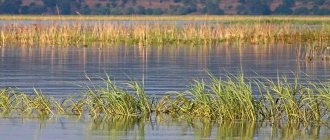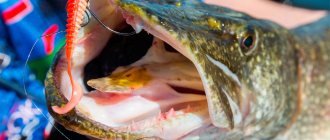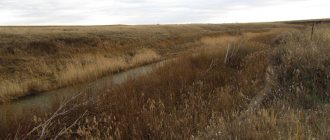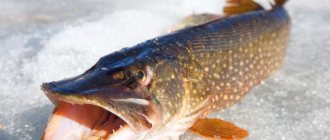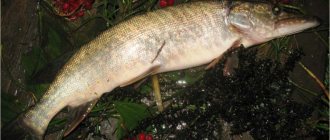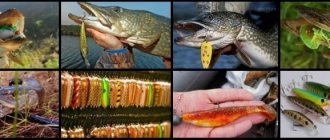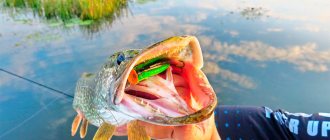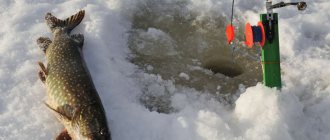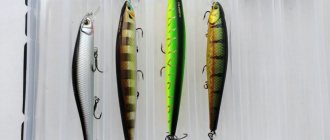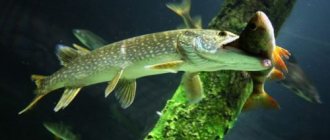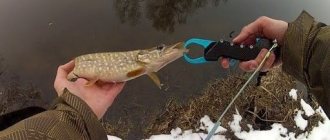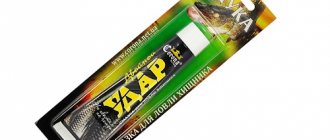Fishing for pike in July is not the easiest – the heat affects the fish’s bite. Therefore, pike fishing in July directly depends on weather conditions. Remember, pike fishing in July can improve dramatically when it gets colder or before a thunderstorm. However, even in hot weather, pike feeds, and therefore will be caught, you just need to choose the right place for pike fishing and know how and what to catch pike in July. Let's figure out which baits are best for pike fishing, what gear is needed for pike fishing, and why pike fishing from a boat is more successful in July.
Summer heat
There is an opinion that pike fishing in July is not as good as in other summer months. After all, the pike bite is negated by the summer heat. In addition, in the hot weather of July, pike, like most other fish, goes to cool depths, and in shallow waters it tries to hide in algae. Therefore, fishing for pike in July is more about catching pike up to one kilogram; large pike in the heat ignore any fisherman’s bait. Pike only go out in search of prey in the early morning or evening.
However, we should not forget the old folk fishing tradition: pike fishing in July can radically change for the better during a sharp cold snap or before a thunderstorm, which the predator senses in advance and begins to greedily grab the bait offered to it.
July is characterized by the fact that the fisherman’s luck largely depends on his patience and perseverance. Indeed, often in search of the desired trophy, a fisherman has to walk more than one kilometer and try more than a dozen spinners until he finds the only one that can seduce the picky pike.
Finding a fishing spot
Since pike behave in a specific way during the hottest month of the year, special attention should be paid to the choice of fishing location. You should also draw a clear boundary between fish in still water and during flow, because its behavior largely depends on the type of reservoir.
The main condition when searching for a site for spinning fishing in July is to determine the suitable temperature and oxygen conditions in a specific place in the reservoir.
It is worth separating deep and shallow lakes and ponds. Since the latter warm up quite strongly in hot weather, the predator is less active in them, and therefore feeds reluctantly. It is better to immediately leave them aside, and focus your attention only on deep-sea lakes.
In reservoirs where the depth is sufficiently large, you can look for holes where the temperature is lower. In such places, the predator usually hides from the July heat and feels better. When the weather is cooler, as well as in the evening and morning, when the sun is no longer hot, the predator comes closer to the shore, where there is underwater vegetation.
Where to catch pike in July
Let's find out where to catch pike in July and how to find promising places for pike fishing.
Experienced fishermen believe that fishing for pike in July will be more effective if you catch it in places such as: the edges of islands, rocky ridges in the coastal zone, bridge supports, deep gullies and holes under the banks, deep bays and backwaters rich in springs, cluttered pools trees falling into the water.
As for the river pike, although it is an order of magnitude stronger and more resilient than the lake pike, it simply does not waste its strength and therefore tries to stay in places where there is a weak current or no current at all.
On those days when fishing for pike in July is completely hopeless, the situation is saved by fishing with small live bait in windows of aquatic vegetation.
Fishing gear in July
Giving any recommendations on gear is a useless exercise, but still the main aspects are worth mentioning. In July, pike are inactive, and catching them with a spinning rod alone is not effective.
You also need to pay attention to live bait gear, such as a donk and a float.
If we talk about spinning, then the rod must have a fast action. In July there is a lot of vegetation in the water, and only a quick formation will help you get into the area of open water.
It is better to use monofilament as fishing line. As we all know, in July there is a lot of poplar fluff in the water, and the braided line will collect it very quickly. Of course, it will stick to the monofilament line, but the main part of it will linger on the tulip.
You can learn about the main aspects of equipment from the article “spinning for pike”
Bottom fishing
Bottom fishing with live bait is very good because we can cast to holes that are usually located far from the shore.
You need to choose the appropriate rod. If fishing is carried out on a river, it is important to choose a long tackle so that by placing it vertically, it will eliminate the influence of the current. Depending on the flow, it is worth choosing a test.
For fishing line, I recommend the same monofilament, and again this is the cost of July fishing, as fluff floats.
The donk should be equipped based on the type of reservoir. If the reservoir is stagnant or there is a slight current, installation with an upper float is suitable.
If there is a significant current, you need to put a sliding weight and place the float at the end of the main line.
In the article bottom fishing with live bait , you can get acquainted in more detail with all the intricacies of fishing and diagrams of various equipment.
Float fishing
Fishing with live bait using float tackle is carried out mainly in stagnant, shallow reservoirs. Everything is very simple here. Fishing is carried out in windows among vegetation, so you can’t do without a long rod.
Although using a reel is not necessary, it is still better to equip your rod with one. When there is a bite, the reel will help you pull out the fish and, if necessary, tire it out.
It is better to use monofilament fishing line with a diameter of up to 0.25mm. The bite is tracked by the float, so there is no need to use braid. The float should hold the bait well in the water column and not allow it to go to depth
Depending on the size of the live bait, different equipment is used. If you are fishing with fry or small live bait, the usual classic equipment will do:
When using large and active live bait, such as rudd, it is better to use a semi-bottom mount:
This equipment will allow you to fix the bait in a certain place, and will not allow it to swim away into the grass. This setup works very well when fishing in small windows of vegetation.
Also, don’t forget about the sharp teeth of the pike. Always use pike leads. They come in steel, Kevlar, etc.
When fishing for pike in July, bait plays an important role. Naturally, artificial baits are used for spinning fishing, and live baits are used for live bait fishing gear, but first things first.
When fishing with a spinning rod, the most important thing to remember is that the water is full of vegetation, and a blade of grass caught on the hook will scare away the pike. In this regard, it is necessary to use non-snacking baits.
Pike fishing in July from a boat
If the angler has a boat in his arsenal, then the chances of catching pike in July increase sharply. Firstly, this month pike, especially large ones, try to stay in holes where the water is cooler; getting to these places from the shore is quite problematic. The process of searching for such holes is as follows. While sailing on a boat, a fisherman using a spinning rod equipped with a heavy sinker determines the location of depressions or holes by the behavior of the load. Having discovered them, the angler is simply obliged to catch them.
Of course, in our time of modern technology, the fishing itself and the search process can be simplified if you use an echo sounder.
Promising places
July is a month when you can’t just come and start catching pike. It will be more accurate, but this approach is often doomed to failure. Above, we discussed which days are best to catch a predator, but another of the most important factors is choosing the right place.
You can find pike this month by following simple logic - if the predator doesn’t like the heat, it means it’s hiding where the water is cooler.
Following this logic, promising places are revealed to us in which it can hide:
- thickets of reeds;
- under trees hanging over the water, forming shade;
- under bridge pilings;
- thickets of water lilies;
- underwater snags;
- shaded areas of the reservoir;
- places where underwater springs run out;
- pits, whirlpools;
- deep bays or backwaters;
Pike in July is better caught in rivers than in standing reservoirs. In rivers, the water is usually cooler and it is easier to find shelter from the sun and places with lower water temperatures. In rivers this month, pike prefer to stand in places with minimal current, and even preferably places where there is no current at all. This is due to saving energy, because staying in the current is an additional waste of energy, of which the predator already has little.
The pike's lack of strength is caused not only by heat and hot water, but also by the rapid growth of aquatic vegetation. Algae interfere with the normal circulation of oxygen in the water, which at this time is sorely lacking not only for predators, but also for peaceful fish.
Often, due to algae, pike are forced to stay in the upper layers of the water, so surface types of baits are very effective. The bait should also be selected based on July conditions, there are some nuances there, but we will talk about baits below.
Having a boat is a very positive thing. By boat you can approach the predator’s secluded places - holes, various snags and other natural or artificial shelters. In addition, from a boat it is very convenient to throw the bait along the reeds, which allows you to pass it right under the nose of the pike, which often ambushes in clearings between reeds or reeds.
Tip: no matter whether you catch pike from a boat or from the shore, always make the retrieve to the end. Pike often take it right under the boat or right next to the shore, when it would seem it’s time to take the bait out of the water!
Fishing for pike with a spinning rod in July
Now let's talk about the gear used to catch pike in July. To a greater extent, many anglers prefer to use spinning tackle when fishing for pike in July, because fishing with it is so interesting and challenging.
It is believed that in July pike prefer medium and small spinners; according to the Mepps classification their size is No. 2 - 3, and according to the Blue Fox classification No. 2 -4. The spinning rod itself can be different, the test can be from 3 to 15 g, from 5 to 20 g, and from 7 to 28 g.
Nylon fishing line is suitable with a diameter of 0.25-0.28, if braided, it can be thinner 0.15 - 0.19. Since in July pike need to be caught only in grassy places, when fishing you cannot do without braid, otherwise you may lose your entire fishing arsenal. In addition, in some cases it is necessary to drag the caught fish through abundant thickets. Catching July pike is unpredictable, the bites can be weak and very greedy and fast, so you must definitely use a leash, it is better if it is at least 20 cm long.
Technique for catching pike with a spinning rod: when fishing with a spinning rod, retrieving should be done at an average pace, because the pike in this period of summer, in most reservoirs, does not even hide in the vegetation, but simply stands near the overgrown bottom - from there the rapid attack occurs.
Spinning tackle for pike fishing
Before you catch pike with a spinning rod, you should immediately understand an important point - you can fish not only with its help. When going fishing, it is better to immediately prepare spinning tackle, a bottom and a float fishing rod.
If one of them does not produce results, the fisherman can use the second one, and thereby increase his chances of catching. An experienced hunter can easily catch a pike with a spinning rod, but it is better to play it safe and take spare equipment with you.
The spinning fishing method requires the correct selection and preparation of individual elements. Of course, each fisherman’s fishing style and selection of gear is different.
Any professional already on a subconscious level feels what is needed to assemble an effective device for a particular type of fishing.
For beginners, it is better to start from several important conditions, the observance of which can significantly help in the fishing process.
Since in most cases it is necessary to catch a predator from overgrown areas of a reservoir where there are clear gaps, it is better to take a fishing rod with a fast action. Such a spinning rod will ensure that the tackle hits the right place.
It is better to use monofilament as the main line. During this period, quite a lot of poplar fluff collects in reservoirs.
If you use braid, fluff will quickly accumulate on the main line. Monofil will also collect it, but not in such quantities.
There must be a leash made of a stronger material so that the fish cannot bite it with its sharp teeth. This element must be no shorter than 20 cm.
Since the predator in July is quite unpredictable and can attack the bait with different forces - from a weak bite to a strong and swift blow, the use of a leash can save the tackle from unnecessary damage.
Fishing for pike in July using a spinning rod - fishing tactics
Fishing for pike in July using a spinning rod begins with examining the reservoir, searching for underwater vegetation, humps, holes and other various obstacles. Therefore, after arriving at the place, it is recommended to equip a spinning jig with a head and probe the bottom.
After examining the reservoir and determining its nature, you can install the wobbler and start hunting. According to many experienced fishermen, it is this type of bait that is most interesting for pike in the hottest month of the year.
Then you can change the bait to another or continue fishing with a wobbler. Predator bites can be sluggish (in most cases) and strong.
Also, different individuals struggle differently after being hooked. In some cases, in order to pull out a small puppy, you have to sweat a lot.
But there are situations that are completely opposite, when after a bite it becomes unclear whether there is a fish or some other object sitting on the hook, and when the fisherman takes the tackle out of the water, it turns out that there is actually a pike sitting there, only very sluggish. Such cases happen much less frequently, but you also need to be prepared for them.
Lures for pike fishing
Now, knowing where to catch pike in July, it’s worth figuring out what to catch it with. Considering that fishing among weeds can damage your bait supply, it is better to use unhooked baits for catching pikes. Let's look at some of them in more detail:
KUUSAMO produces lures for pike fishing, so-called “shakers” with antennae.
The advantage of such baits is that they can be used for catching pike both in open areas and in the grass. The spoon has decent weight and a streamlined shape, thanks to which it flies well and can penetrate deep into the thickets. It is there that large pike like to hide during the July heat.
However, the large weight of such a spinner also has its disadvantages: it falls to the bottom very quickly, so immediately after landing the spinner it is necessary to reel in. Reeling is carried out as follows: first you need to slowly pull it along the grass, and when the spoon reaches the area of clean water, then lower it with a slight twitch to the edge of the algae. This spoon is also good because it works until the very last moment of reeling, and for pike hunting this is a very valuable property, because pike often attacks right at the surface of the water.
The next bait for catching pike in July is the fairly common Minnow Spoon from Rapala. For fishing in abundant thickets, this spoon is much more profitable than the previous one. It falls upward with a hook and almost never catches the grass. It is better to throw such a bait directly onto the grass on the surface of the water, and then sharply pull it into the water and reel it in very slowly, twitching slightly. You can use another wiring option. If the thickets are not too dense, for example, water lilies do not grow very often, then you should try to throw the spoon directly onto the surface of the grass, then jerk it onto another grass. After this, the spoon will begin to smoothly descend into the water. Just at this moment the pike will attack the bait.
The last bait for pike fishing in July, which will be discussed, called a popper glider, is no less effective for catching pike in places overgrown with grass. It consists of a popper connected to what looks like a wide wobbler and a hook pointing upward. Catching pike with such bait is very interesting, especially in places where there is grass and a lot of clean water. In thickets you need to carefully drag the bait, and in clear water use it as a popper. Of course, a glider popper quite often catches algae; its advantage is that it can be used where it is impossible to use a regular popper with a treble hook. At the same time, pike bites perfectly on such bait.
Be sure not to forget the landing nets, because July is not the time when the pike will humbly follow into the hands of the fisherman; even a small specimen will surprise you with its desperate fight for its life.
Gear selection
It is difficult to say which tackle will be the most effective in catching July pike. It’s different on all bodies of water. On lakes and ponds, densely overgrown with reeds and water lilies, mugs have proven themselves well. Moreover, both drifting at the will of the wind and anchored. It is difficult for pike to find coolness in stagnant water. Exhausted by the heat, she would rather covet a roach or crucian carp, whose movement is limited by the length of the leash, than an artificial bait. For her, this is an easy prey; there is no need to chase after her and waste energy.
Fishing with mugs
It is advisable to re-equip store-bought mugs, since the equipment in them is often far from ideal. It includes a monofilament line with a diameter of 0.30 to 0.40 mm, a sinker, a special leash and a tee hook. You need to wind the required supply of fishing line around the circle, about 10 meters more than the depth in the place where the tackle will be used. The sinker is a lead olive weighing 10-15 g. The hook is selected according to the size of the bait fish and the expected size of the predator that is planned to be caught. Usually this is a tee No. 4-8 according to the international classifier. Particular attention should be paid to the choice of leash. Many fishermen use fluorocarbon that is invisible in the water. It really increases the number of bites, but there are also a lot of annoying cuts. Pike have sharp teeth that cut through fluorocarbon line like a knife through butter. Therefore, it is better to use a titanium, tungsten or steel leash at least 20 cm long.
The circles are placed from the boat in a promising area so that the live bait is at a height of 50 cm above the bottom surface. The distance between the circles is at least 10 meters, this will prevent tangling of gear. It is important that they are all in sight. After this, the fisherman can only carefully observe them and respond to bites in a timely manner.
Live bait fishing rod
You can effectively catch pike in July using a live bait fishing rod, which can compete with any pike gear. It differs from a fly or match one by the presence of a special leash in the equipment and the greater strength of all elements. This is a stronger rod, a thick fishing line, a reliable hook, and a voluminous, clearly visible float.
Standard live bait consists of:
- Bolognese fishing rod equipped with guides;
- inertial or inertialess coil;
- monofilament with a cross-section of 0.30-0.35 mm (or braided cord with the same breaking load);
- a large bright float, the carrying capacity of which does not allow bait fish to sink to the saving bottom;
- olive-shaped weight (if necessary, additionally loaded with pellets);
- any type of hook (single, double, tee).
You can fish with a live bait rod both from the shore and from a boat. The technique is simple: you need to place a live bait on a hook (preferably behind the back) and throw the tackle in the chosen place. Live bait differs favorably from other gear for catching pike in that it can be used in the most difficult areas of the reservoir. For example, in plant thickets, where there is a high probability of snagging. It’s also convenient for fishing in currents while fishing. Live bait can be led along the edge of the grass, holding the equipment at those points where the predator is supposed to be in ambush.
Spinning fishing
Summer is a good time for spinning tackle. In July, pike fishing with a spinning rod is carried out from a boat, from a gently sloping bank or cliff; if necessary, you can strip to the waist and fish wading. The fishing method influences the choice of spinning rod. On a boat it is easier to use short rods up to 2.1 meters, from the shore - 2.4 m and more. A fast action blank with a test load of 5 to 20 g is suitable, but this is not the rule. Both the test and the class of the rod can be any; such characteristics must correspond to the conditions on the reservoir and the weight of the bait used.
Anglers targeting toothy fish equip a spinning rod with:
- inertia-free with spool 2000-3000;
- braided cord with a thickness of 0.12-0.16 mm (minimum margin - 100 m);
- swivel clasp;
- a leash made of hard material that can withstand the pressure of sharp pike teeth.
As for baits, experienced spinning fishermen give only two recommendations. First, they shouldn't be big. In the heat, the predator is not ready to attack large baits; their time will come in the fall, with the first drop in temperature. Secondly, you should select baits that can play attractively on a slow retrieve. In the summer, only a slowly swimming lure or silicone can awaken the predatory instinct of a pike... And right in front of its nose)).
Lures for asp in July
The asp, like any predator, can be caught using all common artificial baits. The only advice is to choose larger and heavier baits. If you are fishing from a boat, then wobblers are perfect; they can be lowered downstream and then slowly begin to be pulled towards you, working with the reel and the tip of the rod. Read also: Rating of the best baits for asp
Wobblers are unlikely to be suitable for fishing from the shore, unless, of course, the fishing takes place in the immediate vicinity of the shore, since not every spinning angler can cast a light bait, and even with a strong side or head wind, at a distance of more than a hundred meters. He would not have been experienced and strong. The best lures for catching asp are oscillating spoons. Especially castmasters, which, due to their heavy weight and specific shape, fly perfectly into the distance in any wind. Various Devons have also proven themselves well, they also have decent weight and also create a sound that attracts the asp when retrieving.
What to catch asp in July
The best summer baits for asp in July
Many anglers prefer to catch sheresper using a bombard. This tackle is a heavy float with which you can throw relatively light baits over a fairly long distance.
